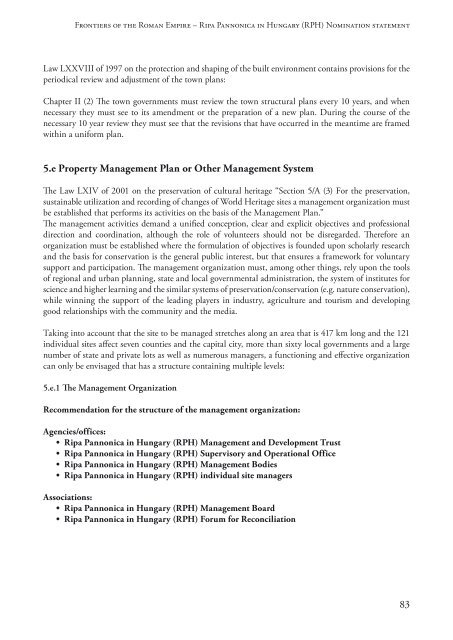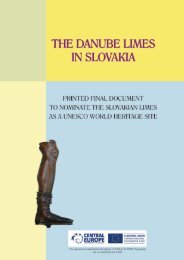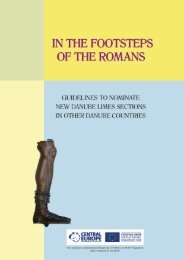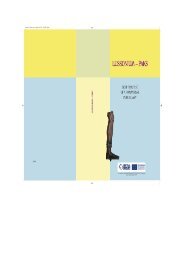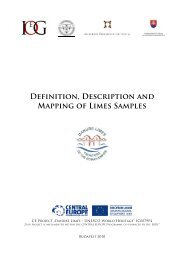the PDF version! - Danube Limes
the PDF version! - Danube Limes
the PDF version! - Danube Limes
Create successful ePaper yourself
Turn your PDF publications into a flip-book with our unique Google optimized e-Paper software.
Frontiers of <strong>the</strong> Roman Empire – Ripa Pannonica in Hungary (RPH) Nomination statement<br />
Law LXXVIII of 1997 on <strong>the</strong> protection and shaping of <strong>the</strong> built environment contains provisions for <strong>the</strong><br />
periodical review and adjustment of <strong>the</strong> town plans:<br />
Chapter II (2) The town governments must review <strong>the</strong> town structural plans every 10 years, and when<br />
necessary <strong>the</strong>y must see to its amendment or <strong>the</strong> preparation of a new plan. During <strong>the</strong> course of <strong>the</strong><br />
necessary 10 year review <strong>the</strong>y must see that <strong>the</strong> revisions that have occurred in <strong>the</strong> meantime are framed<br />
within a uniform plan.<br />
5.e Property Management Plan or O<strong>the</strong>r Management System<br />
The Law LXIV of 2001 on <strong>the</strong> preservation of cultural heritage “Section 5/A (3) For <strong>the</strong> preservation,<br />
sustainable utilization and recording of changes of World Heritage sites a management organization must<br />
be established that performs its activities on <strong>the</strong> basis of <strong>the</strong> Management Plan.”<br />
The management activities demand a unified conception, clear and explicit objectives and professional<br />
direction and coordination, although <strong>the</strong> role of volunteers should not be disregarded. Therefore an<br />
organization must be established where <strong>the</strong> formulation of objectives is founded upon scholarly research<br />
and <strong>the</strong> basis for conservation is <strong>the</strong> general public interest, but that ensures a framework for voluntary<br />
support and participation. The management organization must, among o<strong>the</strong>r things, rely upon <strong>the</strong> tools<br />
of regional and urban planning, state and local governmental administration, <strong>the</strong> system of institutes for<br />
science and higher learning and <strong>the</strong> similar systems of preservation/conservation (e.g. nature conservation),<br />
while winning <strong>the</strong> support of <strong>the</strong> leading players in industry, agriculture and tourism and developing<br />
good relationships with <strong>the</strong> community and <strong>the</strong> media.<br />
Taking into account that <strong>the</strong> site to be managed stretches along an area that is 417 km long and <strong>the</strong> 121<br />
individual sites affect seven counties and <strong>the</strong> capital city, more than sixty local governments and a large<br />
number of state and private lots as well as numerous managers, a functioning and effective organization<br />
can only be envisaged that has a structure containing multiple levels:<br />
5.e.1 The Management Organization<br />
Recommendation for <strong>the</strong> structure of <strong>the</strong> management organization:<br />
Agencies/offices:<br />
• Ripa Pannonica in Hungary (RPH) Management and Development Trust<br />
• Ripa Pannonica in Hungary (RPH) Supervisory and Operational Office<br />
• Ripa Pannonica in Hungary (RPH) Management Bodies<br />
• Ripa Pannonica in Hungary (RPH) individual site managers<br />
Associations:<br />
• Ripa Pannonica in Hungary (RPH) Management Board<br />
• Ripa Pannonica in Hungary (RPH) Forum for Reconciliation<br />
83


